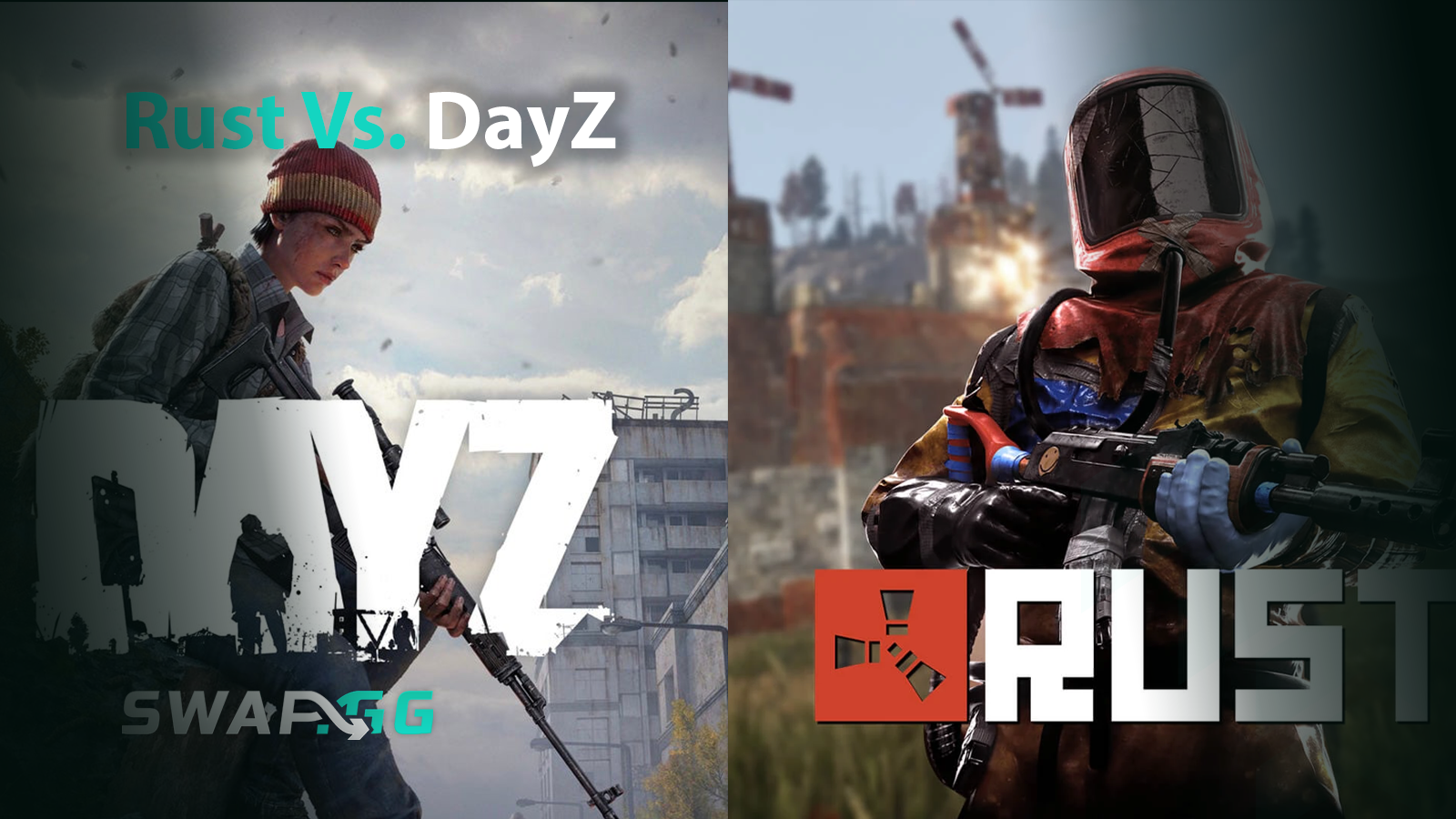Rust vs. DayZ: Which Game Should You Play?

Diposting pada di RustDayZ

If you’ve ever found yourself torn between the brutal chaos of Rust and the gritty realism of DayZ, you’re not alone. Both games dominate the survival genre, but each caters to vastly different play styles. This article breaks down their core mechanics, communities, and overall experiences to help you decide which post-apocalyptic journey deserves your time.
1. Game Overview: Origins and Settings
Rust
Released in February 2018 by Facepunch Studios after a lengthy Early Access period (starting in December 2013), Rust drops players onto a procedurally generated island teeming with dense forests, labyrinthine caves, and eerie abandoned monuments. The game’s unofficial mantra, "survive through creativity or brute force", encapsulates its open-ended design. Players scavenge resources, craft tools, and build bases ranging from humble wooden huts to sprawling metal fortresses. With no predefined goals, the experience is shaped entirely by player choice: cooperate, betray, raid, or explore. Notably, Rust expanded to consoles in May 2021, broadening its audience.
DayZ
Developed by Bohemia Interactive, DayZ spent five years in Early Access (2013–2018) before its full release in December 2018. Set in the fictional Eastern European nation of Chernarus, the game immerses players in a 225 km² sandbox ravaged by a zombie apocalypse. Every decision carries weight: permadeath means losing hours of progress with a single mistake, and survival hinges on realism-driven mechanics like managing blood loss, infections, and fractured limbs. The game’s unforgiving environment, complete with dynamic weather and scarce resources, forces players to weigh risk against reward at every turn.
Key Differences in Setting
- Rust: Procedural generation ensures no two islands are identical.
- DayZ: Fixed Chernarus map rewards intimate knowledge of terrain.
- Focus: Rust leans into creative freedom and player-driven conflict, whereas DayZ prioritizes gritty realism and emergent storytelling.
2. Survival Mechanics: Realism vs. Creativity
Rust
Rust thrives on action-oriented gameplay that prioritizes progression and player-driven conflict. Players gather resources like wood, stone, and metal to craft tools, weapons, and increasingly complex bases-from flimsy wooden shelters to reinforced metal fortresses. Base-building is central to the experience, with players deploying traps, turrets, and strategic layouts to defend against raids. Combat is frequent and chaotic, featuring guns, explosives, and even rockets, encouraging aggressive playstyles. While survival elements like hunger and radiation exist, they are slightly simplified to prioritize accessibility, allowing players to focus on PvP and collaborative building.
DayZ
DayZ leans into methodical realism, where survival hinges on meticulous attention to detail. Hunger, thirst, and injuries require precise management- players must craft splints for fractures, administer blood transfusions, and scavenge antibiotics to combat infections. Resources are scarce, and finding essentials like bullets or canned food can mean the difference between life and death. The lack of tutorials forces players to learn through trial and error. Permadeath amplifies the tension, as a single mistake can erase hours of progress, encouraging cautious and deliberate decision-making.
Key Differences
- Rust: Rewards aggression and strategic building, with systems tailored for fast-paced PvP and collaborative base construction.
- DayZ: Prioritizes realism and consequence, demanding patience, precision, and adaptability in an unforgiving survival environment.
3. PvP vs. PvE: Conflict or Coexistence?
Rust
PvP is the core of Rust’s design, with servers acting as lawless battlegrounds where players raid bases, ambush travelers, and fight over critical resources like metal and explosives. The game’s "no sacred zones" philosophy ensures constant vulnerability, where players’ sleeping bags (respawn points) can even be destroyed. While PvE servers exist, offering a combat-free experience, they are a minority compared to the chaotic competition of standard Rust gameplay. Mechanics like raiding timers and loot scarcity actively incentivize conflict, making aggression the default strategy.
DayZ
DayZ offers a balance between PvE and optional PvP, creating a tense and unpredictable ecosystem. Zombies serve as a persistent environmental threat, but the real danger often lies in player interactions. Unlike Rust, combat isn’t inevitable: some servers foster cooperative communities for trading, while others encourage paranoia and solo survival tactics ("going rogue"). Permadeath heightens the stakes, as one poorly timed PvP encounter could cost players days or weeks of progress. This dynamic allows players to choose their level of engagement, whether avoiding conflict entirely or seeking out PvP opportunities.
Key Differences
- Rust: Thrives on relentless competition, with PvP deeply interwoven into its mechanics (e.g., raiding and loot scarcity).
- DayZ: Emphasizes player agency, blending PvE survival with optional PvP that adapts to server dynamics and individual risk tolerance.
4. Player Interaction: Community Dynamics
Rust
Rust’s community thrives on dynamic alliances and betrayals, shaped by its ruthless PvP environment. Players often band together to construct sprawling bases, but greed or rival clans frequently cause dramatic collapses. Voice chat plays a critical role in coordinating raids, negotiating truces, or taunting enemies, although toxic behaviors like griefing and trolling can dominate interactions. The game’s “every man for himself” ethos fosters unpredictability: one moment, you’re peacefully trading resources with strangers, and the next, your base is reduced to rubble by rocket attacks. While this chaotic volatility creates moments of hilarious drama, it can alienate players seeking a more cooperative experience.
DayZ
DayZ cultivates a lonelier, tension-filled atmosphere. Trust is rare, and even seemingly friendly encounters, such as sharing a campfire, carry the risk of betrayal, as the scarcity of loot encourages opportunistic behavior. Communication relies on subtle gestures, in-game radios, or cautious voice chats, avoiding the overt coordination seen in Rust. The persistent world ensures that actions have lasting consequences: a looted safe zone or an abandoned backpack becomes part of the environment’s evolving narrative, shaping emergent survival stories. For example, players may form temporary alliances to combat zombie hordes or disease outbreaks, only to dissolve them once immediate threats are addressed.
Key Differences
- Rust: Encourages high-stakes social gameplay with raiding, trading, and voice-driven drama, often prioritizing conflict over cooperation.
- DayZ: Focuses on unpredictable, fleeting interactions where trust is fragile, and survival hinges on the ability to gauge others’ intentions.
5. Performance and Accessibility
5. Performance and Accessibility
Rust is optimized for mid-to-high-end PCs and consoles, featuring customizable graphics settings that allow players to balance visual fidelity and performance. The game requires a 64-bit OS, a DirectX 11-compatible GPU such as the GTX 670 2GB or R9 280, and 35–40GB of storage, with SSDs strongly recommended for optimal load times. Its robust modding community offers quality-of-life tweaks, including FPS optimizers and server plugins, enhancing accessibility and customization. Modern CPUs with 4 or more cores benefit from the game’s multi-threaded performance, resulting in smoother gameplay and higher frame rates. Although no official AccessKit integration is documented, Rust’s active development frequently introduces optimizations for diverse hardware configurations, improving scalability.
DayZ demands capable hardware, particularly for physics calculations and large-scale environments, with CPU performance playing a critical role. Older benchmarks suggested Intel’s advantage in single-threaded tasks, but modern AMD Ryzen CPUs (e.g., 5000/7000 series) deliver comparable performance. Console versions on last-gen hardware (Xbox One/PS4) suffer from inconsistent frame rates, while current-gen systems (Series X/S, PS5) achieve smoother gameplay, often hitting 60 FPS. Modding in DayZ is supported via the Steam Workshop, though the scope is narrower than Rust’s, prioritizing a curated survival experience. Persistent servers in DayZ maintain progress between updates, though patches occasionally introduce instability, affecting performance.
Key Differences
Key Differences
- Rust prioritizes modding flexibility and performance scalability across a wide range of hardware tiers, with SSD storage strongly recommended to achieve faster load times and optimal performance.
- DayZ emphasizes environmental realism and survival mechanics, requiring stable CPU performance. It benefits significantly from current-gen console hardware upgrades, achieving smoother gameplay with frame rates of up to 60 FPS on newer systems, while last-gen consoles often drop below 30 FPS. DayZ’s modding tools, available via Steam Workshop, offer fewer customization options compared to Rust and focus on delivering a curated survival experience.
6. Updates and Longevity
Rust maintains its momentum with monthly updates and community-driven refinements that continuously evolve the game’s experience. Recent updates in 2025 include the Primitive Update, which introduced siege weapons, shields, and a medieval-themed game mode, as well as the Jungle Update, which brought significant environmental enhancements. Additionally, the Softcore mode received a refresh with deployable debris and revamped respawn mechanics. Facepunch Studios places great emphasis on performance optimization, evident in improvements like Linux server enhancements and occlusion defaults for anti-cheat systems, alongside quality-of-life changes such as deployables snapping to walls and corrected scrap costs for the Kit Machine. The game’s longevity is clear from its record-breaking engagement metrics, including over 260,000 concurrent players in 2025, 5.5 million unique players in 2024, and a staggering 40 million hours played in that year. However, vanilla servers often require frequent wipes, such as blueprint and map resets, to counterbalance resource scarcity and player power imbalances.
DayZ adopts a "slow and steady" approach to updates, historically prioritizing realism and immersion over rapid content drops. The game’s tradition of immersive overhauls, ranging from refined AI behavior to enhanced survival mechanics, aligns with the expectations of its dedicated community. Player feedback often highlights the challenge of balancing server persistence with meaningful mechanical updates, ensuring the game retains its immersive core rather than chasing novelty.
Key Differences
- Rust excels through rapid iteration, delivering regular monthly content updates and seasonal events that keep the gameplay fresh and engaging. It ensures constant reinvention through community-driven tweaks and refinements.
- DayZ, on the other hand, prioritizes depth and realism over frequent updates, with its development philosophy focused on maintaining immersion and delivering substantial game overhauls when necessary.
Comparison Table - Rust VS DayZ
Conclusion: Which Should You Choose?
Your decision between Rust and DayZ hinges on what you value most in a survival experience:
- Rust caters to players who thrive on fast-paced PvP, creative base-building, and community-driven chaos. With frequent updates like the Rust+ companion app and a vibrant modding scene, it rewards strategic combat and adaptability. However, its constant threats and regular server wipes demand resilience.
- DayZ, on the other hand, appeals to those seeking methodical realism and immersive storytelling. Its permadeath mechanic and scarcity-driven gameplay force calculated decisions, while the 2023 "2.0" update refined its gritty atmosphere, albeit with a slower developmental pace.
Both games deliver unforgettable survival journeys, but Rust is a sandbox of relentless ambition, whereas DayZ is a test of endurance against all odds. Choose Rust to build an empire under siege- or DayZ to fight for every dawn.
Diposting pada di RustDayZ
![[THUMBNAIL] Is 7.1 Surround Good for CS2? The Reality Behind Virtual Audio](https://swap.gg/cdn-cgi/image/f=auto/https://blog.swap.gg/content/images/2025/12/Is-7.1-Surround-Good-for-CS2_.png)
![[THUMBNAIL] Is CS2 CPU or GPU-intensive? What Hardware Actually Matters](https://swap.gg/cdn-cgi/image/f=auto/https://blog.swap.gg/content/images/2025/12/Is-CS2-CPU-or-GPU-intensive_.png)
![[THUMBNAIL] What Is the Cheapest Knife in CS2? Your Complete Budget Guide](https://swap.gg/cdn-cgi/image/f=auto/https://blog.swap.gg/content/images/2025/12/cheapest-knives.png)